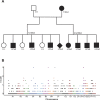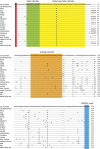Whole Genome Sequencing Identifies a Missense Mutation in HES7 Associated with Short Tails in Asian Domestic Cats
- PMID: 27560986
- PMCID: PMC4997960
- DOI: 10.1038/srep31583
Whole Genome Sequencing Identifies a Missense Mutation in HES7 Associated with Short Tails in Asian Domestic Cats
Abstract
Domestic cats exhibit abundant variations in tail morphology and serve as an excellent model to study the development and evolution of vertebrate tails. Cats with shortened and kinked tails were first recorded in the Malayan archipelago by Charles Darwin in 1868 and remain quite common today in Southeast and East Asia. To elucidate the genetic basis of short tails in Asian cats, we built a pedigree of 13 cats segregating at the trait with a founder from southern China and performed linkage mapping based on whole genome sequencing data from the pedigree. The short-tailed trait was mapped to a 5.6 Mb region of Chr E1, within which the substitution c. 5T > C in the somite segmentation-related gene HES7 was identified as the causal mutation resulting in a missense change (p.V2A). Validation in 245 unrelated cats confirmed the correlation between HES7-c. 5T > C and Chinese short-tailed feral cats as well as the Japanese Bobtail breed, indicating a common genetic basis of the two. In addition, some of our sampled kinked-tailed cats could not be explained by either HES7 or the Manx-related T-box, suggesting at least three independent events in the evolution of domestic cats giving rise to short-tailed traits.
Figures



Similar articles
-
Whole genome sequencing in cats, identifies new models for blindness in AIPL1 and somite segmentation in HES7.BMC Genomics. 2016 Mar 31;17:265. doi: 10.1186/s12864-016-2595-4. BMC Genomics. 2016. PMID: 27030474 Free PMC article.
-
Whole exome sequencing in an Indian family links Coats plus syndrome and dextrocardia with a homozygous novel CTC1 and a rare HES7 variation.BMC Med Genet. 2015 Feb 10;16:5. doi: 10.1186/s12881-015-0151-8. BMC Med Genet. 2015. PMID: 25928698 Free PMC article.
-
Multiple mutant T alleles cause haploinsufficiency of Brachyury and short tails in Manx cats.Mamm Genome. 2013 Oct;24(9-10):400-8. doi: 10.1007/s00335-013-9471-1. Epub 2013 Aug 15. Mamm Genome. 2013. PMID: 23949773 Free PMC article.
-
Oscillatory links of Fgf signaling and Hes7 in the segmentation clock.Curr Opin Genet Dev. 2013 Aug;23(4):484-90. doi: 10.1016/j.gde.2013.02.005. Epub 2013 Mar 4. Curr Opin Genet Dev. 2013. PMID: 23465881 Review.
-
Mapping, fine mapping, and molecular dissection of quantitative trait Loci in domestic animals.Annu Rev Genomics Hum Genet. 2007;8:131-62. doi: 10.1146/annurev.genom.8.080706.092408. Annu Rev Genomics Hum Genet. 2007. PMID: 17477823 Review.
Cited by
-
Patterns of allele frequency differences among domestic cat breeds assessed by a 63K SNP array.PLoS One. 2021 Feb 25;16(2):e0247092. doi: 10.1371/journal.pone.0247092. eCollection 2021. PLoS One. 2021. PMID: 33630878 Free PMC article.
-
Development and Application of a High-Resolution Melting Analysis with Unlabeled Probes for the Screening of Short-Tailed Sheep TBXT Heterozygotes.Animals (Basel). 2022 Mar 21;12(6):792. doi: 10.3390/ani12060792. Animals (Basel). 2022. PMID: 35327188 Free PMC article.
-
Fine-mapping and identification of candidate causal genes for tail length in the Merinolandschaf breed.Commun Biol. 2022 Sep 6;5(1):918. doi: 10.1038/s42003-022-03854-3. Commun Biol. 2022. PMID: 36068271 Free PMC article.
-
Cardiomyopathy associated 5 (CMYA5) implicated as a genetic risk factor for radial hemimelia in Siamese cats.J Feline Med Surg. 2023 Oct;25(10):1098612X231193557. doi: 10.1177/1098612X231193557. J Feline Med Surg. 2023. PMID: 37791865 Free PMC article.
-
Combined GWAS and 'guilt by association'-based prioritization analysis identifies functional candidate genes for body size in sheep.Genet Sel Evol. 2017 Apr 28;49(1):41. doi: 10.1186/s12711-017-0316-3. Genet Sel Evol. 2017. PMID: 28454565 Free PMC article.
References
-
- Hickman G. C. The mammalian tail: a review of functions. Mamm Rev 9, 143–157 (1979).
-
- Beck C. M. Development of the vertebrae tailbud. Wiley Interdiscip Rev Dev Biol 4, 33–44 (2015). - PubMed
-
- Casaca A., Santos A. C. & Mallo M. Controlling Hox gene expression and activity to build the vertebrate axial skeleton. Dev Dyn 243, 24–36 (2014). - PubMed
-
- Wahi K., Bochter M. S. & Cole S. E. The many roles of Notch signaling during vertebrate somitogenesis. Semin Cell Dev Biol 49, 68–75 (2016). - PubMed
Publication types
MeSH terms
Substances
LinkOut - more resources
Full Text Sources
Other Literature Sources
Miscellaneous

